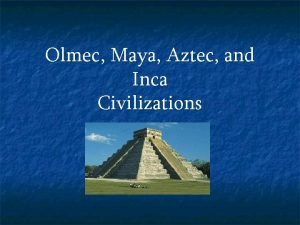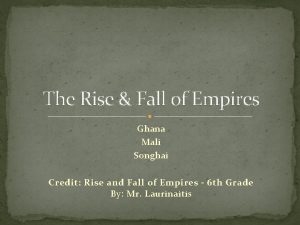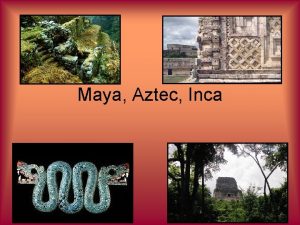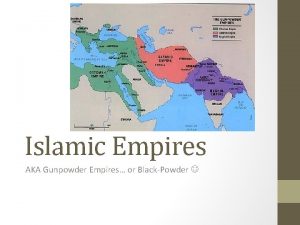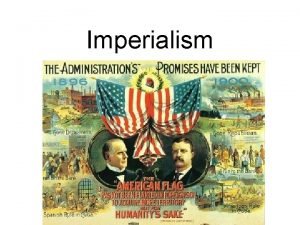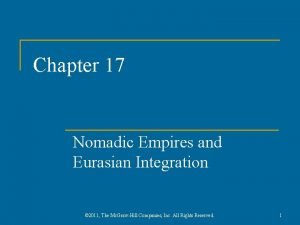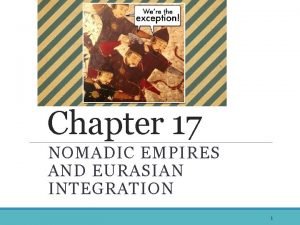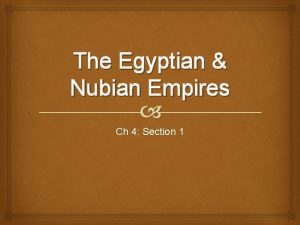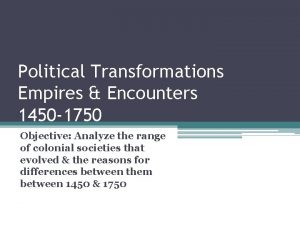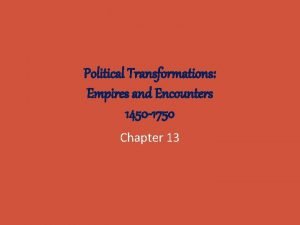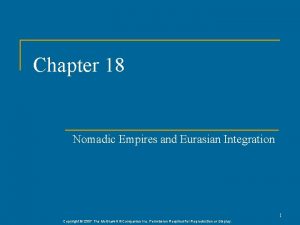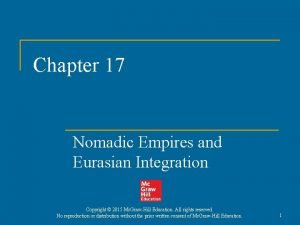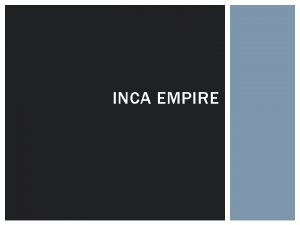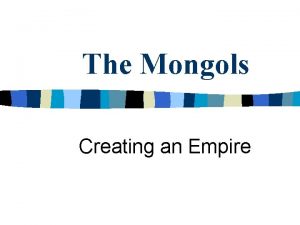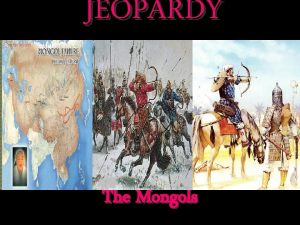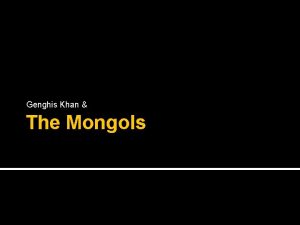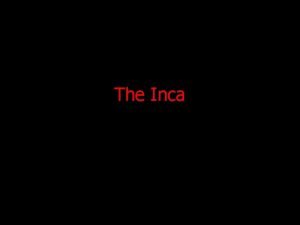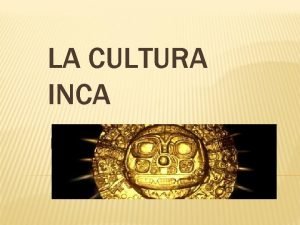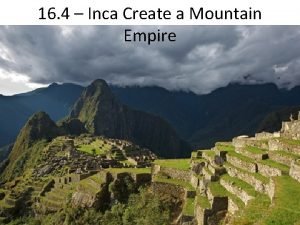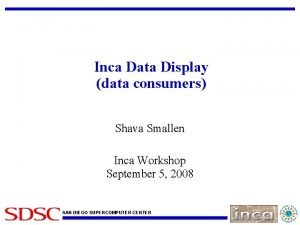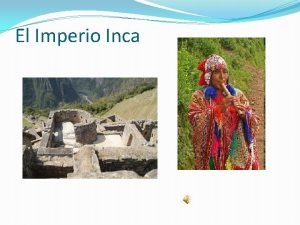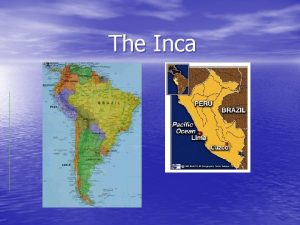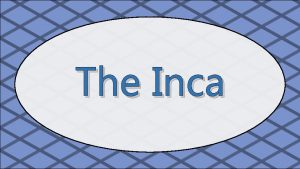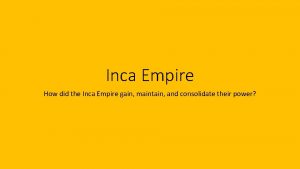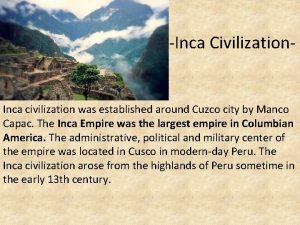The Mongols Empires Video Mongols Mali and Inca



















- Slides: 19

The Mongols

Empires Video – Mongols, Mali and Inca � http: //www. learner. org/courses/worldhistory /unit_video_11 -1. html? pop=yes&pid=2154#

Nomads of the Asian Steppe � Steppe: vast area of dry grassland � It stretches across Eurasia � It served as a land trade route � Home to nomadic people who roamed and conquered areas surrounding them.



Nomadic Way of Life � Pastoralists: herded domesticated animals. � Constantly on the move searching for pastures to feed their herds. � Mostly traveled on horseback. � Traveled together in groups called clans. � Different clans joined together if large force was needed to attack

Steppe Nomads and Settled Societies in peaceful trade most of the time � If empires were weak and divided powerful nomadic groups attacked. � Engaged

Rise of the Mongols

� Mongols roamed loosely in organized clans. � Around 1200 military and political genius unites the Mongols – Temujin � Genghis Khan which meant “Universal Ruler” united the Mongols. � 1206 – Kuriltai convenes and chooses Temujin as the KHAGAN ◦ Kuriltai – meeting of all Mongol leaders

Genghis the Conqueror � Brilliant Organizer- assembled warriors into fighting force – organized army into TUMENS ◦ Tumens – units of 10, 000 soldiers � Strategist: he used war tricks to confuse the enemy � Used cruelty and fear as a weapon: terrified enemies into surrendering.

Mongol Conquests � The Mongols began to conquer much of Asia � He began with China in 1211 and launched the “campaign of terror” across Central Asia. � They destroyed city after city and slaughtered many inhabitants. � 1225: Central Asia was under Mongol Control � By Genghis Khan’s death in 1227, the Mongols controlled Asia from the North China sea to Persia � He made Karakorum the capital of his empire

� He became the patron of artists and intellectuals in areas he conquered � He gathered great thinkers from many places of his empire at Karakorum � His son Ogedai was chosen by the kariltai to succeed him as the Great Khan � The Empire was divided by his sons and one of his grandsons into 4 khanates � Ogedai continued conquest and expanded the empire


THE MONGOL EMPIRE

The Four Khanates

The Mongol as Rulers � Harsh warriors, but were tolerant in peace once land was conquered. � Did not impose their beliefs or way of life on conquered people. � Adopted cultures of some of the people they ruled. � Pax Mongolica: 1200 s-1300 s period of peace, stability and law and order across Eurasia ◦ - allowed for the safe passage of trade, travelers and missionaries. ◦ Merchants were the greatest beneficiaries of the peace

Khanate of the Golden Horde � One of the four divisions of Genghis Khan’s empire � Its goal was to conquer Europe � Conquered almost all of Russia and reached Hungary � Mongols allowed Russians to practice their religion and culture � Effects of Mongol rule on Russia: ◦ Led to the rise of autocratic rulers ◦ Separated Russia from the rest of Europe so that it did not share a common history with western European countries

Mongols in China � Kublai Khan – grandson of Genghis Khan conquers China and ends the Song Dynasty � He sets up the Yuan Dynasty � He becomes the next Great Khan � Only time in Chinese history that it is ruled by foreigners � Chinese and Mongol cultures are kept separate and intermarriage is forbidden � It was during Kublai Khan’s rule that Marco Polo visited China

Mongols in China � Yuan Khan dynasty ended with the death of Kublai ◦ Chinese always resented foreign rule ◦ Mongol rule was weakened after two failed attempts to conquer Japan – maybe Heaven did not favor them? ◦ Secret sects cause instability � Replaced by the Ming Dynasty
 Maritime vs land based empires
Maritime vs land based empires Olmec maya aztec inca map
Olmec maya aztec inca map Rise and fall of ghana empire
Rise and fall of ghana empire Mayans incas aztecs map
Mayans incas aztecs map Video yandex ru
Video yandex ru Gravity yahoo
Gravity yahoo Videos yahoo search
Videos yahoo search The frame size of a video refers to the video’s
The frame size of a video refers to the video’s Are vikings turkic
Are vikings turkic How did the ottoman safavid and mughal empires arise
How did the ottoman safavid and mughal empires arise The policy of establishing colonies and building empires
The policy of establishing colonies and building empires Chapter 17 nomadic empires and eurasian integration
Chapter 17 nomadic empires and eurasian integration Nomadic empires and eurasian integration
Nomadic empires and eurasian integration Chapter 4 section 1 the egyptian and nubian empires
Chapter 4 section 1 the egyptian and nubian empires Political transformations empires and encounters
Political transformations empires and encounters Chapter 5 political transformations empires and encounters
Chapter 5 political transformations empires and encounters Gunpowder empires characteristics
Gunpowder empires characteristics Chapter 18 nomadic empires and eurasian integration
Chapter 18 nomadic empires and eurasian integration Chapter 17 nomadic empires and eurasian integration
Chapter 17 nomadic empires and eurasian integration Chapter 16 people and empires in the americas
Chapter 16 people and empires in the americas

